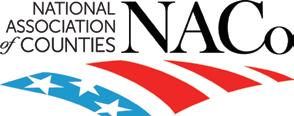
12 minute read
NACo News Updates

www.naco.org
About NACo – The Voice of America’s Counties
National Association of Counties (NACo) is the only national organization that represents county governments in the U.S. NACo provides essential services to the nation’s 3,068 counties. NACo advances issues with a unified voice before the federal government, improves the public’s understanding of county government, assists counties in finding and sharing innovative solutions through education and research and provides value-added services to save counties and taxpayers money.
FCC halts efforts to cap inmate phone call rates in county jails
By Jacob Terrell
The Federal Communications Commission (FCC) has halted its efforts to cap the rates that inmates pay when placing phone calls from jails and prisons.
In 2015, the FCC had implemented rules that capped the rates paid by inmates to between 14 cents and 22 cents per minute. This rule was later challenged in the U.S. Court of Appeals by prison phone companies who claimed the FCC did not have the authority to cap prices for inmate calls.
However, as the FCC’s lawyers were in the process of defending the commission’s position, two of the three sitting Democrat commissioners on the five-person commission vacated their seats leaving a new Republican majority that did not support the rate caps.
Since the new majority has been in place, a letter was sent to the U.S. Court of Appeals stating that the FCC would no longer defend its previous position defending the implementation of rate caps for phone calls placed by inmates.
The case, though, is not over. Although the FCC is sitting on the sidelines, the court case has continued in a hearing earlier this month at the D.C. Court of Appeals.
A portion of the profits made by companies that provide phone services in jails are returned to the jail as “commissions.” As a result, this revenue can directly impact county jail operating budgets.
According to the National Sheriffs’ Association, whose members operate approximately 80 percent of the nation’s jails, jails incur significant costs in providing phone services to inmates due to factors ranging from taking security measures to ensure that phone calls aren’t used to engage in criminal activities to recording and storing phone calls to be provided to the courts.
House moves to kill election-security agency
The U.S. House of Representatives’ Committee on House Administration voted 6–3 along party lines to advance the Election Assistance Commission Termination Act (H.R. 634).
H.R. 634 would eliminate the Election Assistance Commission (EAC), an independent, bipartisan agency created to help states secure their voting systems and the only agency responsible for making sure voting machines cannot be hacked.
After the 2000 presidential election, EAC was directed to convey federal help to states to update and improve their voting systems. In recent years, EAC’s top responsibilities have been to ensure elections are accessible to all individuals, develop and promote election best practices and allocate funds for elections technologies. While H.R. 634 aims to eliminate the EAC, it does not propose new agencies to take care of its responsibilities.
In response to the vote, several voting rights organizations have expressed concerns to the committee about the security of the United States’ election system and public confidence in the general election system. These concerns have been heightened due to possible foreign interference in the recent U.S. presidential election.
H.R. 634 will now move to the full House for a vote.
County officials are traditionally responsible for overseeing the allocation of voting machines, managing polling locations and ensuring the integrity and efficiency of the voting process in partnership with federal, state and other local election officials. Counties take deliberate steps to ensure the security of voting systems, from ensuring that voting machines are not connected to the internet or to each other to establishing a specific chain of custody for voting records.
Before the 2016 presidential election, NACo released a new fact sheet on the role counties play in administering and ensuring the integrity of America’s election process. It can be viewed online at www.naco.org/vote.
Drones: latest technology on county radar
By Kevan Stone
In 1783, the first hot-air balloon was launched and mankind could finally touch the sky. 1903 saw the famous Wright Brothers flight and the first helicopter flight soon followed in 1907. It stayed that way for nearly a century. Eventually, we began to hear of the U.S. military using something called a “drone” to conduct reconnaissance and eventually military warfare campaigns across the world. It was indeed a brave new world.
Fast forward to today, and we find ourselves welcoming the first new aerial technology in nearly a century. A technology that anyone can own. While manned aircraft was exorbitantly expensive to purchase, an unmanned aerial system or UAS — AKA “drone” — is not. While this brings a wealth of opportunity for local governments, it also brings with it many new challenges.
Counties have been using drone technology for public safety and infrastructure inspection. Going where man cannot without danger is a vital resource local governments have been quick to embrace.
Instead of asking someone to enter a burning building to search for endangered citizens or asking a county engineer to strap on a harness and check out that bridge, drones can perform this task just as well with no risk of injury.

NACo
Up until 2014, approximately 430,000 drones were sold to U.S. consumers. But the market has taken off since then, In 2016, more than 1 million drones were purchased. Chances are, your neighbor or relative owns a drone.
The FAA, cognizant of the rapid expansion of this technology, issued a formal rule in June 2016 regarding drone operations, known as Part 107.
It detailed what drone pilots can or cannot do, such as stating the pilot must be able to see the drone at all times during flight (a visual line of sight), mandating flights can only take place during daylight and designating a maximum speed and altitude, among many others. While released in the name of safety, Part 107 does not answer all concerns posed by county government.
In August 2016, the FAA announced it was creating a Drone Advisory Committee. This committee would officially provide recommendations to the FAA for future regulations and rulemaking. With over 400 applicants, NACo was successful in having one of its own, former Riley County, Kan. commissioner Robert Boyd, appointed to this committee. Its members — including the drone industry, drone technology, federal advocacy and other stakeholders — began meeting in October 2016.
Privacy, governance and federal pre-emption are issues that matter most to county government. Since its inception, the FAA has controlled the skies, from the blade of grass in one’s backyard, to the heavens.
While this has held true for manned aircraft, local governments have had some control in terms of ordinances and laws controlling certain aspects of flights. For example, while local government cannot claim jurisdiction of aircraft flight, it can control where that aircraft takes off from and can control the times of day when takeoff and landing are permitted.
No-fly zones, while federally regulated, have been requested by local governments for sensitive infrastructure and special events. The same principle should apply to drone flight, where the ease of access is much simpler since anyone can walk into a store and buy a drone.
County governments, while proponents of drone technology, are on the front line of responding to UAS issues, being responsible for certain enforcement.
While not specifically mandated by the FAA, law enforcement must attend to laws being broken, whether they be with a car, bike or drone. Airports must rely on law enforcement to ensure drones do not veer into takeoff and landing approaches and protected airspace.
Local police must take the call when privacy is invaded. It is for these and many other reasons that local governments must be actively involved with federal stakeholders as these laws formulate.
While everyone agrees drones are here to stay, local government’s role will continue to be of the utmost importance in policy implementation. Through education and collaboration with federal stakeholders, an environment that protects the public while allowing UAS enthusiasts to safely control their craft, can be reached.
Continued From Page 49 <<<
Advertiser Resource Index
AAC Risk Management . . . . . . . . . . . . . . . . . . . . . . . . . . . . . . . . . . . . . . . . . . . . . . . . . . . . . . . . . . . . . . . . . . . . . . 45 AAC Workers’ Compensation Trust . . . . . . . . . . . . . . . . . . . . . . . . . . . . . . . . . . . . . . . . . . . . . . . . . . . . . . . . . . 47 DataScout . . . . . . . . . . . . . . . . . . . . . . . . . . . . . . . . . . . . . . . . . . . . . . . . . . . . . . . . . . . . . . . . . . . Inside Front Cover Apprentice Information Systems, Inc . . . . . . . . . . . . . . . . . . . . . . . . . . . . . . . . . . . . . . . . . . . . . . . . . . . . . . . . . . . 23 Crews and Associates . . . . . . . . . . . . . . . . . . . . . . . . . . . . . . . . . . . . . . . . . . . . . . . . . . . . . . . . . . . . . . . Back Cover Custom Pavement Maintenance and Safety . . . . . . . . . . . . . . . . . . . . . . . . . . . . . . . . . . . . . . . . . . . . . . . . . . . . . 19 Guardian RFID . . . . . . . . . . . . . . . . . . . . . . . . . . . . . . . . . . . . . . . . . . . . . . . . . . . . . . . . . . . . . . . . . . . . . . . . . . . . . 48 Ergon Asphalt & Paving . . . . . . . . . . . . . . . . . . . . . . . . . . . . . . . . . . . . . . . . . . . . . . . . . . . . . . . . . . . . . . . . . . . . . . . 4 Financial Intelligence . . . . . . . . . . . . . . . . . . . . . . . . . . . . . . . . . . . . . . . . . . . . . . . . . . . . . . . . . . . . . . . . . . . . . . . . 17 Nationwide Insurance . . . . . . . . . . . . . . . . . . . . . . . . . . . . . . . . . . . . . . . . . . . . . . . . . . . . . . . . . . . . . . . . . . . . . . . 13 Rainwater Holt & Sexton, PA . . . . . . . . . . . . . . . . . . . . . . . . . . . . . . . . . . . . . . . . . . . . . . . . . . . . . . . . . . . . . . . . . . 3 Southern Tire Mart . . . . . . . . . . . . . . . . . . . . . . . . . . . . . . . . . . . . . . . . . . . . . . . . . . . . . . . . . . . . . . . . . . . . . . . . . 51 Tax Pro . . . . . . . . . . . . . . . . . . . . . . . . . . . . . . . . . . . . . . . . . . . . . . . . . . . . . . . . . . . . . . . . . . . . . . . . . . . . . . . . . . . 10
This publication was made possible with the support of these advertising partners who have helped to underwrite the cost of County Lines. They deserve your consideration and patronage when making your purchasing decisions. For more information on how to partner with County Lines, please call Christy L. Smith at (501) 372-7550.
LITTLE ROCK, AR PERMIT No. 2797
OUR MOST VALUABLE INVESTMENTS ARE IN RELATIONSHIPS.


When Crews & Associates was formed in 1979, the capital base was modest but the vision was bold: to build a solid foundation of long-term client relationships. How? By using a unique combination of product experience, work ethic, integrity and extraordinary service. Over the past 30+ years, that strategy has served us – and our clients – very well. Today, our team is stronger than ever, and we’re just as committed to being fully invested.
A First Security Company



